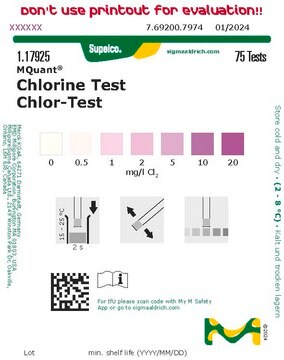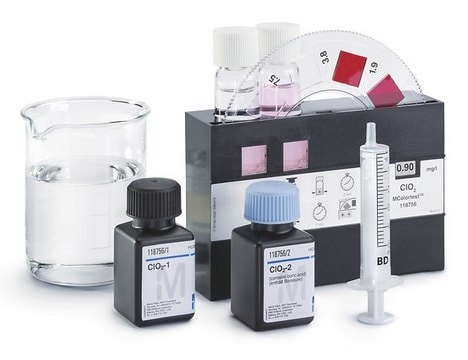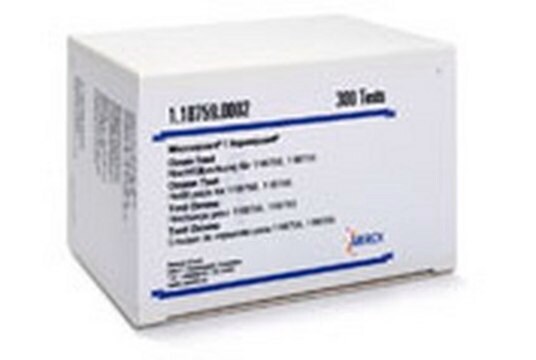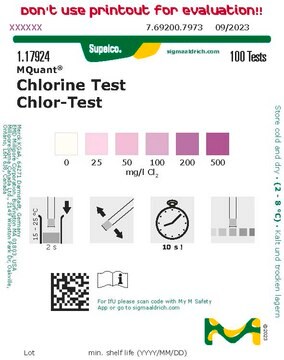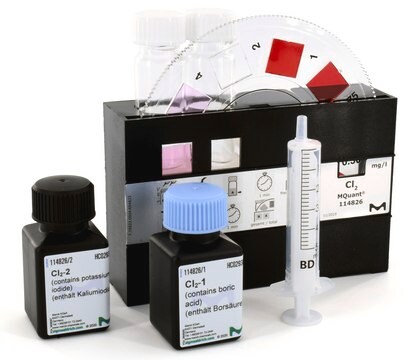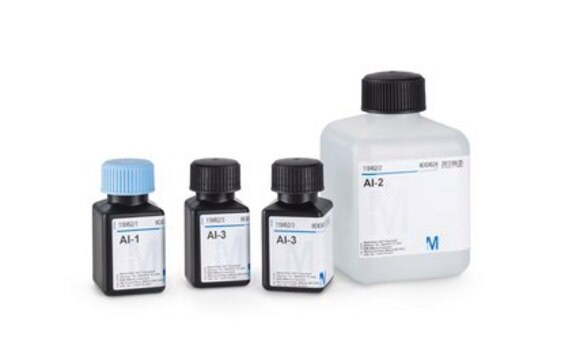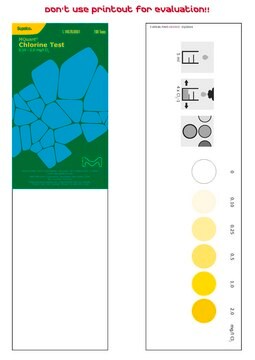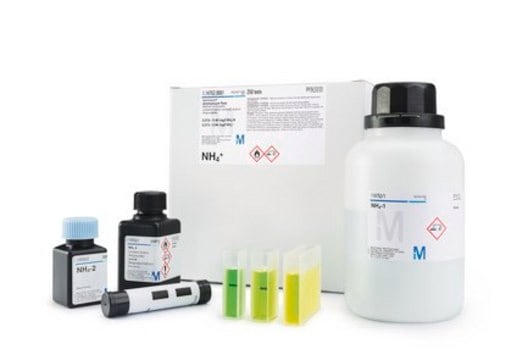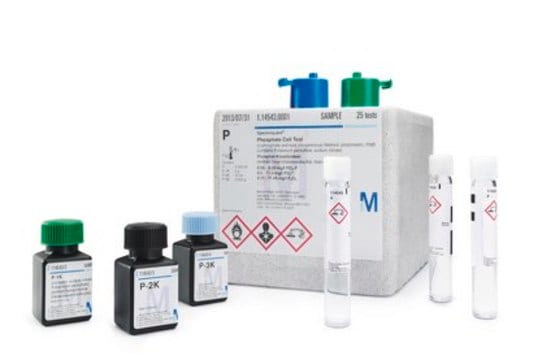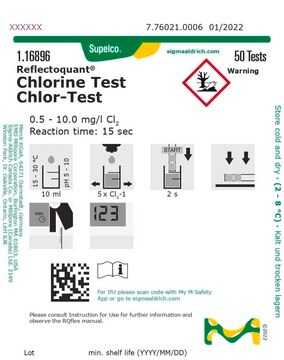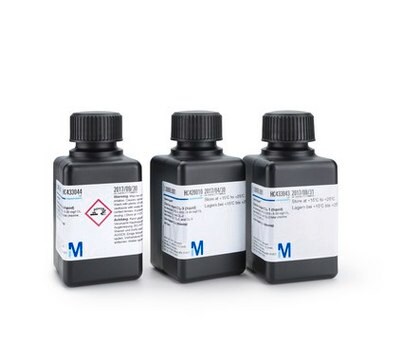推荐产品
产品名称
氯测试, colorimetric, 0.1-2.0 mg/L (Cl2), for use with MQUANT®
產品線
MQuant®
品質等級
特定分析物
chlorine
測量範圍
0.1-2.0 mg/L (Cl2)
相容性
for use with MQUANT®
檢測方法
colorimetric
儲存溫度
15-25°C
相关类别
一般說明
该测试可用于
- 地下水和地表水
- 饮用水和矿泉水
- 水产养殖水
- 废水
- 电镀废水
- 消毒溶液
此测试不适用于海水。
分析方法
在弱酸性溶液中,游离氯与二乙基对苯二胺(DPD)反应形成红紫色染料。在存在碘化钾的情况下,在该反应中还测量了结合氯。通过目视比较测量溶液的颜色与色盘色域,可以半定量测量氯浓度。
该测试基于透射光法对显色反应进行评估。因此,即使对于浑浊和有色水样,也可以进行分析,无需任何准备。
色盘由耐用、耐晒的塑料材质制成,适用于工业领域和潮湿的环境。
原始试剂盒可通过包含所有试剂的补充包1.14979延长其使用寿命,是一种特别实惠的生态系统产品。
應用
- 水处理和消毒:氯检测对于确保水消毒工艺的安全性和有效性至关重要。准确测量游离氯和总氯含量是既保持适当的消毒效果,同时最大限度地减少有害消毒副产物 (DBP) 形成的关键。最近的研究集中关注了海水中的氯反应动力学及其对杀生物剂有效性和环境安全的影响(Kinani et al., Critical Reviews in Analytical Chemistry, 2022)。
- 环境监测:氯检测用于监测各种环境基质(例如河流、湖泊和废水)中的氯含量。这对于评估氯化对水生生态系统的影响、确保遵守环境法规至关重要。采用先进的色谱和质谱技术对海水中氯产生的氧化剂及其副产物进行形态分析 (Roumiguières et al., Critical Reviews in Analytical Chemistry, 2023)。
- 公共卫生和饮用水安全:确保饮用水安全是一大关键问题。氯检测有助于保持适当的氯平衡,以在有效控制病原体的同时,避免可能导致健康风险的过度氯化。为确保符合安全标准,可采用滴定法和比色法等一系列分析方法测量饮用水中的余氯(Ko et al., Chinese Journal of Analytical Chemistry, 2022)。
- 工业应用:氯检测在各种涉氯工业工艺中必不可,例如在纸张和纺织品生产以及冷却水系统中。准确监测氯含量有助于优化这些工艺,确保遵守安全和环境法规(Kinani et al., Critical Reviews in Analytical Chemistry, 2022)。
- 光化学降解研究:氯检测也用于涉及污染物光化学降解的研究。例如,已有人用反应曲面法,研究在水溶液使用降解药物的 UV/游离氯工艺,以优化条件,实现最大效率(Arman et al., International Journal of Environmental Analytical Chemistry, 2022)。
法律資訊
訊號詞
Danger
危險聲明
危險分類
Eye Dam. 1 - Met. Corr. 1 - Skin Corr. 1A
儲存類別代碼
8A - Combustible, corrosive hazardous materials
水污染物質分類(WGK)
WGK 2
其他客户在看
实验方案
AQA Standard for free chlorine - Preparation of a standard solution for free chlorine
AQA Standard for free chlorine - Preparation of a standard solution for free chlorine
AQA Standard for free chlorine - Preparation of a standard solution for free chlorine - Preparation of a stock solution of free chlorine: First prepare a 1:10 dilution using a sodium hypochlorite solution containing approximately 6 - 14 % of active chlorine. For this pipette 10 ml of sodium hypochlorite solution into a calibrated or conformity-checked 100-ml volumetric flask and then make up to the mark with water for analysis.
我们的科学家团队拥有各种研究领域经验,包括生命科学、材料科学、化学合成、色谱、分析及许多其他领域.
联系技术服务部门